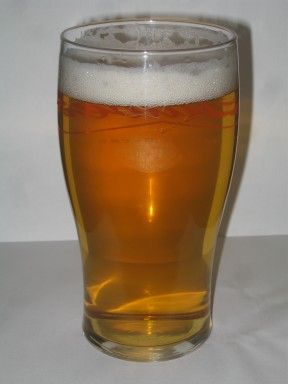In the original post, I gave a laundry list of concerns, ranging from increased color formation to decreased fermentability, and while I don’t want to generalize too much based on a single beer, I don’t think that any of those were borne out in this particular batch. I don’t think the beer could have come out any lighter (with the exception of a couple wits, this is probably the lightest-colored beer I’ve brewed), and the FG came in right on target. As for the various effects of Maillard products on flavor, this probably isn’t the best style to use for comparison. In a beer with a more pronounced melanoidin character, a slight reduction in highly-kilned base malts (Vienna, Munich, Biscuit, Aromatic et al.) and/or boil time would probably allow you to approximate an existing recipe with minimal tweaking.

Anyway, on to the beer itself. It is what it is. A blonde ale isn’t something to turn my head anyway, let alone one that was essentially designed to be… if not insipid, certainly uninspired. The macro lager crowd certainly does seem to be sucking it down, which I choose to interpret as positive feedback. Head retention and lacing are good, which is always encouraging to see in a all-malt, low-hopped beer. I can also read the proverbial newspaper through it, although as usual my consumer-grade camera fails to capture the true appearance of the glass. Filters and finings are for chumps.
I chose Palisade for this beer because it’s supposed to be the closest substitute for Willamette, which is one of my all-around favorite hops. I’d agree with that; however, I don’t think I’ll be using it much in the future. It has that musty/earthy element that I sometimes pick up when noble-type hops are used late in the boil. In this beer, that’s particularly prominent in the aroma. Yakima Chief’s Hop Varietal Guide puts the caryophyllene content of Palisade at roughly double that of Willamette, and while I don’t want to get too reductive here, I’d wager that has something to do with it, especially with the true noble cultivars also having high caryophyllene levels – though none as high as Palisade.
Sometime in the next couple months, I’m going to brew an IPA using ice to top off and make an 8-9 gal batch. That should provide an interesting counterpoint to this beer, at least in terms of the effect on hop utilization, flavor, and aroma. Since my IPA grist would typically be around 20% light Munich, it may also highlight any effects on melanoidin production.

[…] the less than full boil other than lower hop util? I actually just posted some thoughts on that: http://seanterrill.com/2011/03/06/partial-boil-followup/ While I don't want to generalize too much based on a single batch, I don't think there are really […]